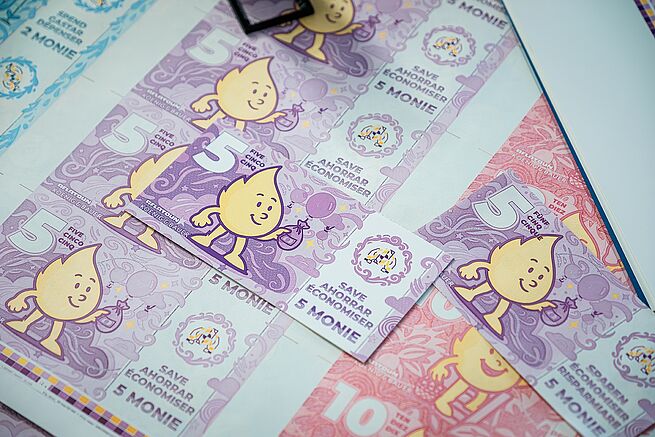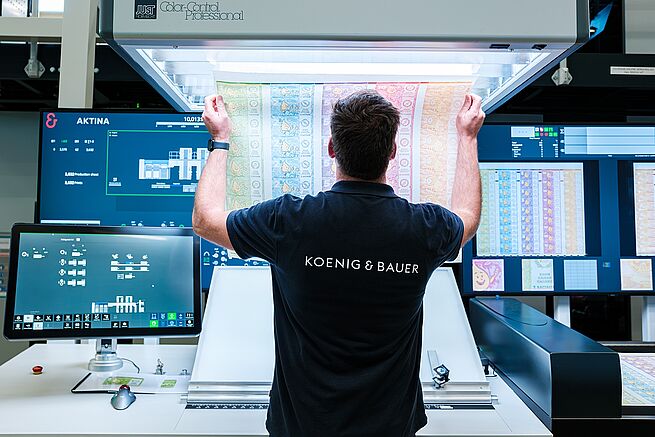- Initiative for cash-based financial education of children and young people
- Core learning tools are educational banknotes and a ‘MoneyBox’ with four compartments for earnings, spending, saving, and borrows
- Extensive pilot phase with over 20,000 learners in 18 countries, including Rwanda, Mexico, and Nepal
- Programme uses tangible interactions to make abstract financial concepts visible and relatable

© Koenig & Bauer
Koenig & Bauer Banknote Solutions, a subsidiary of Koenig & Bauer AG, and Aflatoun International are launching a tangible, cash-based learning system called ‘MoneyBox’ to make financial education available to children and young people worldwide. The initiative will provide meaningful impact data on the educational power of banknotes in society.
The ‘MoneyBox’ initiative underlines Koenig & Bauer’s conviction that cash is an indispensable tool that forms the basis for responsible financial literacy and autonomous living.
Making financial education tangible
The ‘MoneyBox’ system is based on the principle that financial understanding begins with physical interaction. The educational banknotes serve as a central element in an interconnected learning system, allowing young learners to interact with a physical budgeting instrument – the ‘MoneyBox’. With four compartments for earnings, spending, saving, and borrows, abstract financial concepts are made visible, relatable, and culturally adaptable. The learning process follows a specific plan that mirrors the reality of challenges and decisions in the learners' lives. The programme was developed in partnership with teachers and educators in various countries, ensuring contextualisation and impact on the community.
Eric Boissonnas, CEO of Koenig & Bauer Banknote Solutions, emphasises: “With ‘MoneyBox’, we utilise the unique power of a banknote for what it truly is: an instrument for self-determination. By combining technological precision with a social purpose, we see the opportunity to redefine the role of money in society – not just as a medium of exchange, but as a medium of independence and learning. The machinery and technology of Koenig & Bauer Banknote Solutions circulate most of the world’s banknotes – which is why we see it as our responsibility to contribute not only with technology but also with education and the promotion of equal opportunities.”
Kirsten Theuns, Director of Strategic Partnerships & Development at Aflatoun International, adds: “Children learn best by doing – that is the foundation of Aflatoun’s active learning approach.” This approach transforms financial education from abstract concepts into practical, joyful, and inclusively designed experiences that are deeply rooted in children’s everyday lives.

© Koenig & Bauer
From security technology to a secure future
The initiative is starting with pilot programmes in Rwanda, Mexico, Nepal, and 15 other countries in partnership with the Aflatoun network. As part of these pilot projects, over 20,000 learners will receive the ‘MoneyBox’ and educational banknotes in their respective national languages.
The ‘MoneyBox’ banknotes were created using authentic banknote design principles, including microprint, security symbolism and narrative illustrations. This links financial literacy to the cultural value of cash. Each ‘MoneyBox’ banknote tells a symbolic story about values that go beyond the purely financial. For example, the banknote for earnings shows a young person planting a seedling – an analogy that teaches that every income requires effort, time, and care, similar to planting a tree. By embedding ecological and social symbolism in the design, the banknotes go beyond pure financial instruction. They encourage young learners to reflect on how resources – be it money, land, time, or trust – are earned, used meaningfully, and shared responsibly.
The programme is designed to promote physical learning. The children and young people go through real-life scenarios in which they create budgets, thus developing an understanding of decisions and compromises. The content is adapted to local economic realities with national partners and is available offline to ensure the programme's goal of inclusion. Furthermore, parents, teachers, and community leaders are involved as active participants.
